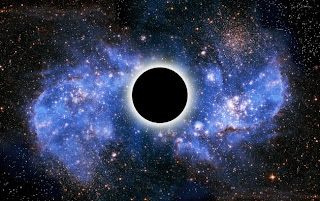This challenges a holy grail of physics, and relates to The Standard Model; how we describe the four forces of nature and how they interact, even the Higgs Boson.
I almost hesitate to post it because many who do not "believe in the Big Bang Theory" will shout: aha! I say: ah, science - self-examining, exploring; learning more tomorrow than we thought we knew yesterday. Quantum mechanics had its trials and tribulations: Weins Law, Rayleigh-Jeans Law and the "ultraviolet catastrophe" eventually getting to Max Planck (of Planck's constant) and light seen as quanta. This eventually led to Einstein and the photoelectric effect in his Annus mirabilis papers generated in a lowly patent office in Munich. Thus we have the Internet, I-phones, flat screens, etc.
This description matches some of the wording I've seen over the years of the "universe as hologram" and admittedly either didn't understand or regarded as new age mystic pop culture. This challenge will have to be peer-reviewed and experiments performed to verify. Stay tuned...
However, Pluto is still not a planet.
A few nine-year-olds will send me hate mail now...
It could be time to bid the Big Bang bye-bye. Cosmologists have speculated that the Universe formed from the debris ejected when a four-dimensional star collapsed into a black hole — a scenario that would help to explain why the cosmos seems to be so uniform in all directions.
The standard Big Bang model tells us that the Universe exploded out of an infinitely dense point, or singularity. But nobody knows what would have triggered this outburst: the known laws of physics cannot tell us what happened at that moment.
“For all physicists know, dragons could have come flying out of the singularity,” says Niayesh Afshordi, an astrophysicist at the Perimeter Institute for Theoretical Physics in Waterloo, Canada.
It is also difficult to explain how a violent Big Bang would have left behind a Universe that has an almost completely uniform temperature, because there does not seem to have been enough time since the birth of the cosmos for it to have reached temperature equilibrium.
In our Universe, a black hole is bounded by a spherical surface called an event horizon. Whereas in ordinary three-dimensional space it takes a two-dimensional object (a surface) to create a boundary inside a black hole, in the bulk universe the event horizon of a 4D black hole would be a 3D object — a shape called a hypersphere. When Afshordi’s team modelled the death of a 4D star, they found that the ejected material would form a 3D brane surrounding that 3D event horizon, and slowly expand.
The authors postulate that the 3D Universe we live in might be just such a brane — and that we detect the brane’s growth as cosmic expansion. “Astronomers measured that expansion and extrapolated back that the Universe must have begun with a Big Bang — but that is just a mirage,” says Afshordi.
Nature: Did a hyper-black hole spawn the Universe?
Physics arXiv: Out of the White Hole: A Holographic Origin for the Big Bang

Comments